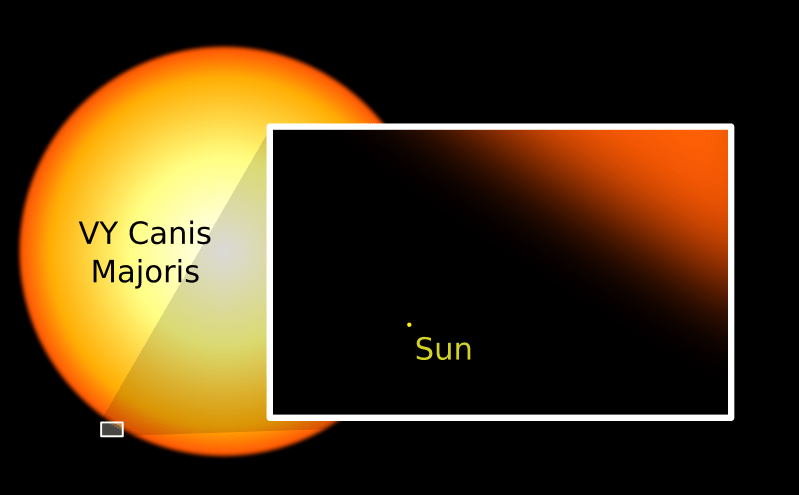As you probably can guess, our Sun is an average star. Stars can be bigger than the Sun, and stars can be smaller. Let's take a look at the size of stars.
The smallest stars out there are the tiny red dwarfs. These are stars with no more than 50% the mass of the Sun, and they can have as little as 7.5% the mass of the Sun. This is the minimum mass you need for a star to be able to support nuclear fusion in its core. Below this mass and you get the failed star brown dwarfs. One fairly well known example of a red dwarf star is Proxima Centauri; the closest star to Earth. This star has about 12% the mass of the Sun, and about 14% the size of the Sun - about 200,000 km across, which is only a little larger than Jupiter.
Our own Sun is an example of an average star. It has a diameter of 1.4 million kilometers... today. But when our Sun nears the end of its life, it will bloat up as a red giant, and grow to 300 times its original size. This will consume the orbits of the inner planets: Mercury, Venus, and yes, even Earth.
An example of a larger star than our Sun is the blue supergiant Rigel in the constellation Orion. This is a star with 17 times the mass of the Sun, which puts out 66,000 times as much energy. Rigel is estimated to be 62 times as big as the Sun.
Bigger? No problem. Let's take a look at the red supergiant Betelgeuse, also in the constellation Orion. Betelgeuse has 20 times the mass of the Sun, and it's nearing the end of its life; astronomers think Betelgeuse might explode as a supernova within the next 1,000 years. Betelgeuse has bloated out to more than 1,000 times the size of the Sun. This would consume the orbit of Mars and almost reach Jupiter.
But the biggest star in the Universe is thought to be the monster VY Canis Majoris. This red hypergiant star is thought to be 1,800 times the size of the Sun. This star would almost touch the orbit of Saturn if it were in our Solar System.
We have written many articles about stars here on Universe Today. Here's an article about the
biggest star in the Universe
, and here's a more detailed article about
red dwarfs
.
If you'd like more information on stars, check out
Hubblesite's News Releases about Stars
, and here's the
stars and galaxies homepage
.
We have recorded several episodes of Astronomy Cast about stars. Here are two that you might find helpful:
Episode 12: Where Do Baby Stars Come From
, and
Episode 13: Where Do Stars Go When they Die
?
References:
http://www.telescope.org/pparc/res8.html
http://en.wikipedia.org/wiki/Proxima_Centauri
http://www.windows2universe.org/sun/statistics.html
http://earthsky.org/brightest-stars/blue-white-rigel-is-orions-brightest-star
 Universe Today
Universe Today
